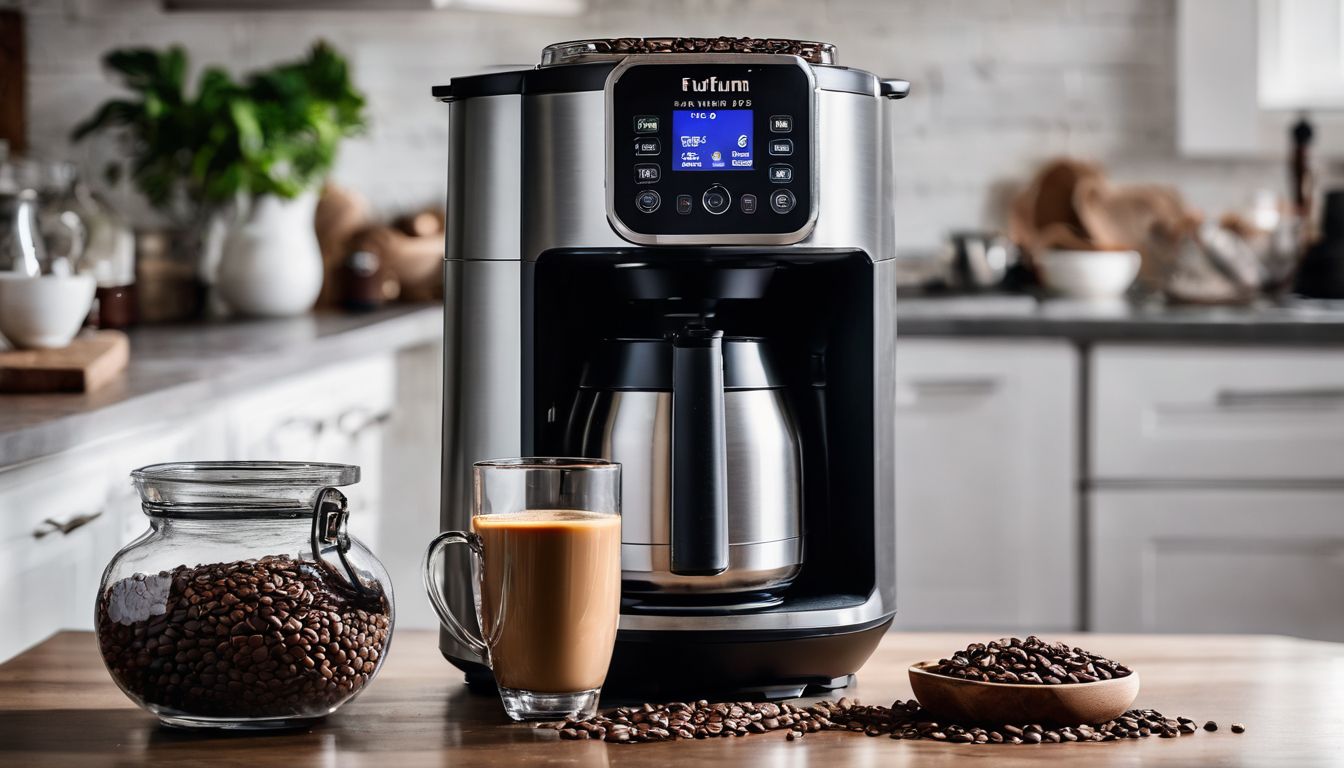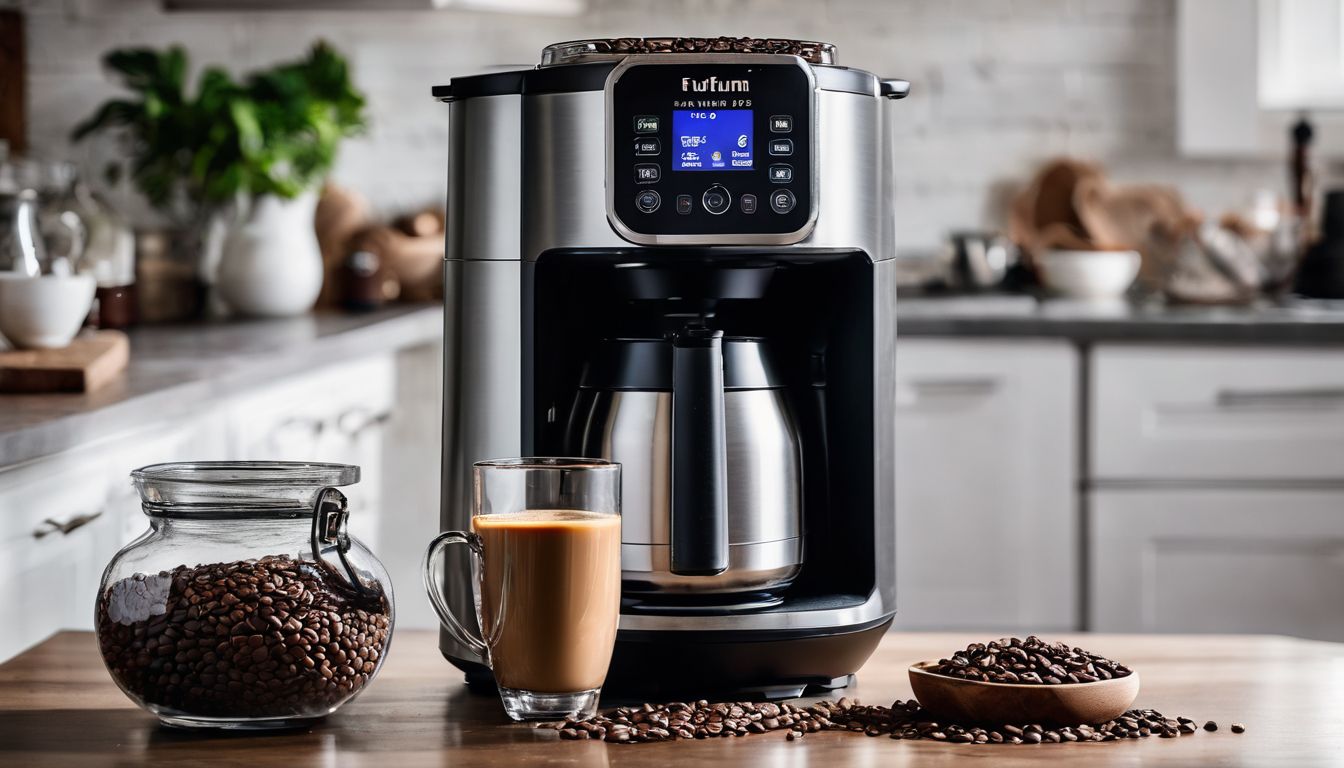
Have you ever eagerly anticipated that first, comforting sip of coffee in the morning, only to be let down by the telltale bitterness of mineral residue lurking within your Instant Pot coffee maker? As someone who’s both navigated the trenches of home cooking and cultivated a deep appreciation for a fine cup of joe, I can confidently say that keeping your machine pristine isn’t just a good practice for hygiene – it’s a cornerstone habit that elevates every delicious gulp.
Let’s get those hands working because this guide is far from your average rinse-and-repeat cleaning spiel. Brimming with techniques I’ve personally vetted—from detailed cleaning rituals designed for leisurely afternoons to swift solutions perfect for when time just isn’t on your side—this article is poised to equip you with all the know-how needed to maintain your beloved coffee dispenser in its best condition.
Trust me, there’s something utterly charming about sipping from a well-tended coffee maker! Are you ready to embrace the art of caffeine craft care? It’s time we jump right into it!
Key Takeaways
- Wash the removable parts of your Instant Pot coffee maker with dish soap to remove oils and residue.
- Decalcify the machine using a mix of water and white vinegar to keep it running well.
- Clean stubborn stains inside the carafe using rice swirled in warm, soapy water.
- Use natural alternatives like baking soda or lemon juice for eco – friendly cleaning.
- Regularly descale and clean your coffee maker to improve taste and extend its lifespan.
The Importance of Regularly Cleaning Your Coffee Maker
Keeping my Instant Pot coffee maker clean is key to great-tasting coffee. Dirt and oils from the beans can build up inside. This makes my brews taste bad over time. I make sure to wash it often so my morning cup is always fresh and delicious.
Scale buildup is another problem I avoid with regular cleaning. Hard water deposits, known as scale, clog the system and slow down brewing. By descaling with vinegar, I keep everything running smoothly.
My machine lasts longer this way too. Clean gear means better performance and more enjoyable coffee every day!
Step-by-Step Guide on How to Clean Your Instant Pot Coffee Maker
Start by washing the removable parts of your coffee maker with dish soap to remove any coffee residue. Then, decalcify the machine using vinegar to remove mineral buildup and improve its performance.
Lastly, clean the carafe with rice to remove stubborn stains and odors, ensuring your coffee maker remains in top condition for delicious brews.
Washing removable parts with dish soap
I clean my Instant Pot coffee maker by washing its removable parts with dish soap. I make sure to remove the carafe, filter basket, and any other removable components before washing them in warm, soapy water.
This helps to get rid of coffee residue and oils that can affect the taste of my brew. While washing, I pay special attention to crevices and hard-to-reach areas using a brush or sponge.
Thoroughly drying all parts before reassembly is crucial to prevent mold or mildew buildup inside the machine.
Decalcifying with vinegar
To decalcify with vinegar, I fill the water reservoir of my Instant Pot coffee maker with a mixture of equal parts water and white vinegar. Then, I run a brew cycle to allow the solution to work through the machine.
After that, I thoroughly rinse the reservoir to ensure no lingering vinegar taste affects my coffee. This process helps remove mineral build-up in the machine and ensures that it continues brewing delicious coffee without any disruptions.
Regularly descaling your coffee maker using this method will not only maintain its performance but also prolong its lifespan. It’s an easy way to tackle scale build-up and keep your Instant Pot coffee maker working efficiently for a long time.
Cleaning the carafe with rice
To clean the carafe with rice, I pour about a quarter cup of uncooked rice into the carafe. Then swish it around in warm, soapy water for a couple of minutes to loosen any coffee residue stuck to the bottom and sides of the carafe.
After that, I rinse it thoroughly with clean water until all the soap and coffee stains are gone.
Using this method is effective because as you swirl the rice around in warm, soapy water, its abrasiveness helps to scrub off stubborn coffee marks inside the carafe without damaging its surface.
Deep-cleaning with vinegar for drip coffee makers
For deep-cleaning a drip coffee maker, fill the water reservoir with equal parts water and vinegar. Run a brew cycle and let half of the mixture sit in the carafe for about 30 minutes.
Then, continue the brew cycle until all the liquid is gone. Afterward, run two more cycles of clean water to rinse thoroughly.
This process helps eliminate mineral buildup inside your machine while ensuring that no vinegar taste taints your next brewed pot. Regularly deep-cleaning ensures optimal performance and delicious coffee without any unwanted residue or impurities lingering in your drink.
Descaling with vinegar for Keurig coffee makers
Now, let’s turn our attention to descaling Keurig coffee makers with vinegar. To begin, unplug the machine and allow it to cool. Then, mix equal parts water and white vinegar in the water reservoir.
Run a brew cycle without a K-cup, and then empty the reservoir.
Next, fill the reservoir with clean water and run multiple brew cycles to rinse out any lingering vinegar taste. Remember to thoroughly dry all removable parts before reassembling your Keurig for use.
Alternative Natural Cleaning Methods
Looking for natural ways to clean your coffee maker? In this section, I’ll discuss alternative cleaning methods using vinegar and baking soda paste, as well as all-natural cleaning options for your Instant Pot coffee maker.
Vinegar and baking soda paste
For tough coffee stains, I mix one part baking soda with two parts hot water to create a paste. Then, I apply this paste to the stained areas and let it sit for at least 15 minutes.
Afterward, I scrub the area gently with a soft brush or sponge before rinsing thoroughly. This natural solution effectively removes stubborn stains without harsh chemicals and keeps my Instant Pot coffee maker looking clean and fresh.
Using vinegar and baking soda paste is an eco-friendly alternative that helps maintain my machine’s performance. It also prevents any lingering taste or odor from affecting the flavor of my freshly brewed coffee, all while being safe for me and the environment.
All-natural cleaning options
I prefer using natural cleaning methods for my Instant Pot coffee maker. Here are some effective and eco-friendly options:
- Vinegar and Baking Soda Paste: Mix equal parts vinegar and baking soda to form a paste. Apply this paste to the interior of the coffee maker, scrub gently, and then rinse thoroughly.
- Lemon Juice Solution: Create a solution of water and lemon juice to clean the exterior of the coffee maker. Wipe down the surface with this solution to remove any stains or residue.
- Citric Acid Soak: Soak removable parts such as the carafe and filter in a solution of warm water and citric acid for a few hours. Then, rinse them thoroughly before reassembling.
- Essential Oil Rinse: Add a few drops of essential oil, such as lemon or orange, to a mixture of water and vinegar for a fresh-smelling rinse after descaling your coffee maker.
- Salt Scrub: Use coarse salt mixed with a little water to create a scrub suitable for cleaning tough-to-reach areas inside the coffee maker.
Tips for Maintaining a Clean and Functioning Instant Pot Coffee Maker
When it comes to maintaining a clean and functioning Instant Pot coffee maker, it’s important to clean the removable parts regularly with dish soap and water. Additionally, make sure to descale your coffee maker with vinegar as often as recommended by the manufacturer for optimal performance.
How often to clean
I clean my Instant Pot coffee maker every month to maintain its performance. Regular cleaning prevents scale build-up, improves the flavor of my coffee, and extends the lifespan of my machine.
The user manual gives me detailed instructions on how often I should descale and clean different parts to ensure that my coffee maker continues to brew delicious coffee.
Specific cleaning tips for different types of machines
When cleaning different types of coffee makers, follow these specific tips:
- For drip coffee makers, wash the removable parts with dish soap and use a vinegar solution to deep-clean the machine.
- In the case of Keurig coffee makers, descale the machine using vinegar to remove mineral build-up that affects performance.
- Single – serve machines should be cleaned with a vinegar solution to prevent clogs and maintain optimal brewing.
Importance of regularly cleaning and descaling.
Now, let’s talk about the essential aspect of maintaining your Instant Pot coffee maker – the regular cleaning and descaling. Regularly cleaning your coffee maker is crucial to keep enjoying great-tasting coffee and preventing any scale buildup that could affect the quality of your brew.
It’s important to clean all removable parts with dish soap and regularly descale with vinegar for optimal functioning. By doing so, you’ll not only extend the lifespan of your machine but also ensure that each cup of coffee maintains its delicious flavor.
Moreover, keeping your Instant Pot coffee maker clean can help resolve issues such as all lights flashing or other operational problems that might arise over time. The user manual provides valuable insights into caring for and effectively cleaning the machine while using household items like vinegar, baking soda, or dish soap.
Conclusion
In conclusion, keeping your Instant Pot coffee maker clean is crucial for great-tasting coffee. The methods provided are practical and efficient, ensuring a smooth cleaning process.
How will you incorporate these easy-to-follow tips into your regular coffee maker maintenance routine? Regular descaling and maintenance will extend the life of your machine and improve the quality of your brews.
Explore the Instant Pot manual for comprehensive care instructions tailored to your specific model. Start fresh with a sparkling clean coffee maker and enjoy consistently delicious cups every time!
FAQs
1. How do I clean my Instant Pot coffee maker with vinegar?
To clean your Instant Pot coffee maker with vinegar, fill the water reservoir with a mixture of equal parts water and white vinegar. Run a brewing cycle, then rinse by brewing just water.
2. Can I use baking soda to clean my coffee maker?
Yes, you can clean your coffee maker with baking soda! Make a solution of baking soda and water, pour it into the reservoir, run a brew cycle, then rinse thoroughly with water.
3. What are some natural ways to descale my coffee maker?
Natural descaling options include using solutions like white vinegar or lemon juice. Fill the reservoir halfway and run a brewing cycle for an effective natural cleaning method.
4. Why should I regularly descale my single-serve Instant Pot coffee maker?
Regularly descaling your single-serve Instant Pot Coffee Maker removes mineral buildup that can affect taste and performance, ensuring delicious cups every time.
5. Where can I find troubleshooting tips if my coffee maker isn’t working right after cleaning?
Check your Coffee Maker user manual for maintenance tips or look up online guides for troubleshooting common problems related to your specific model’s maintenance guide.






















